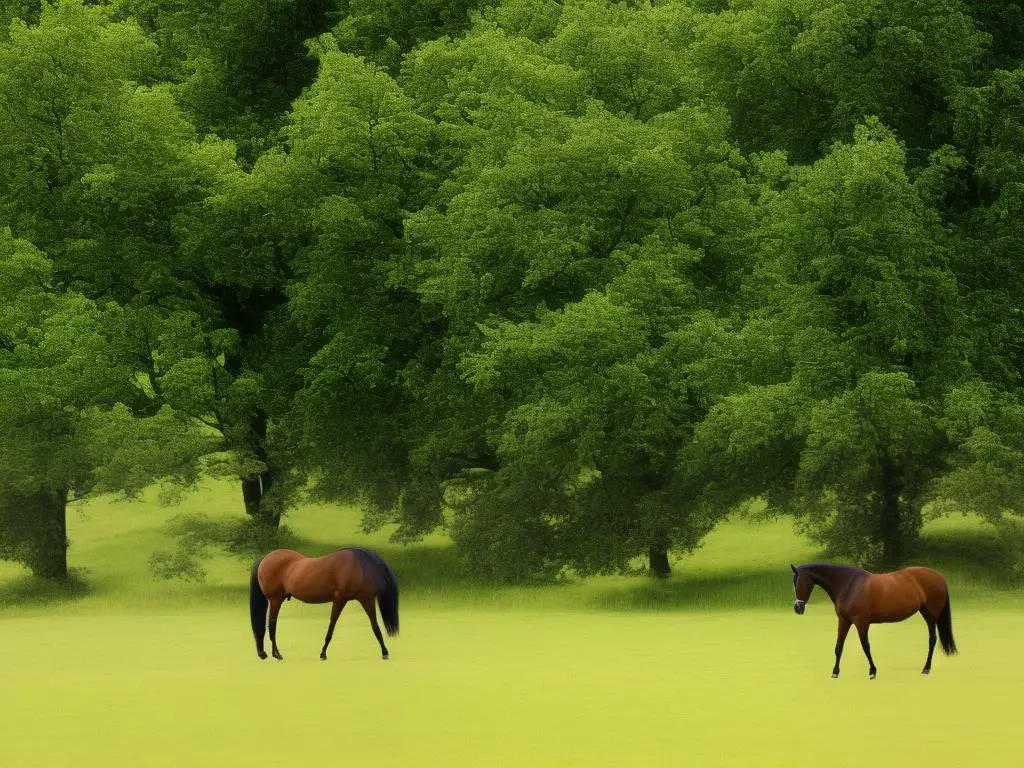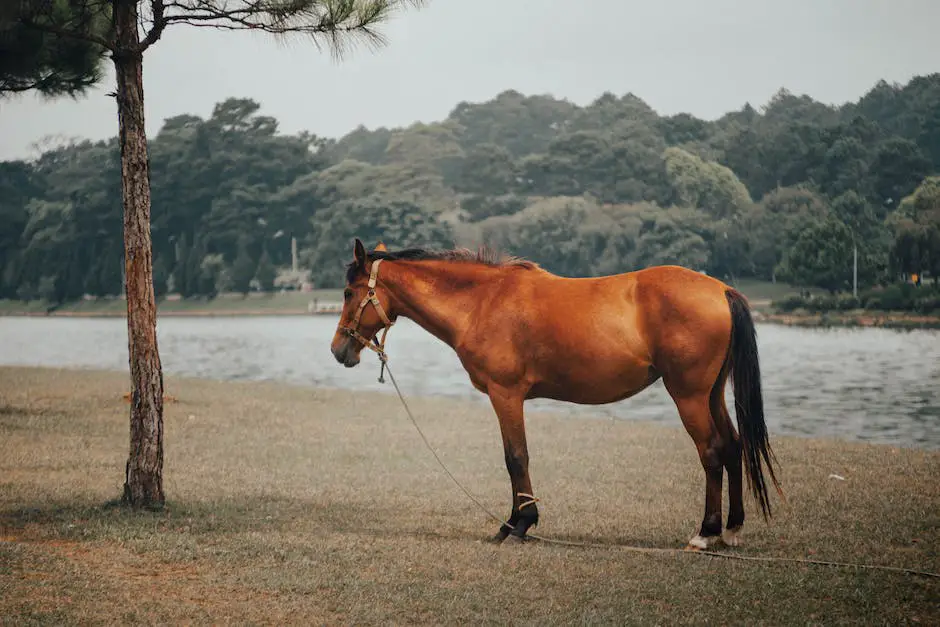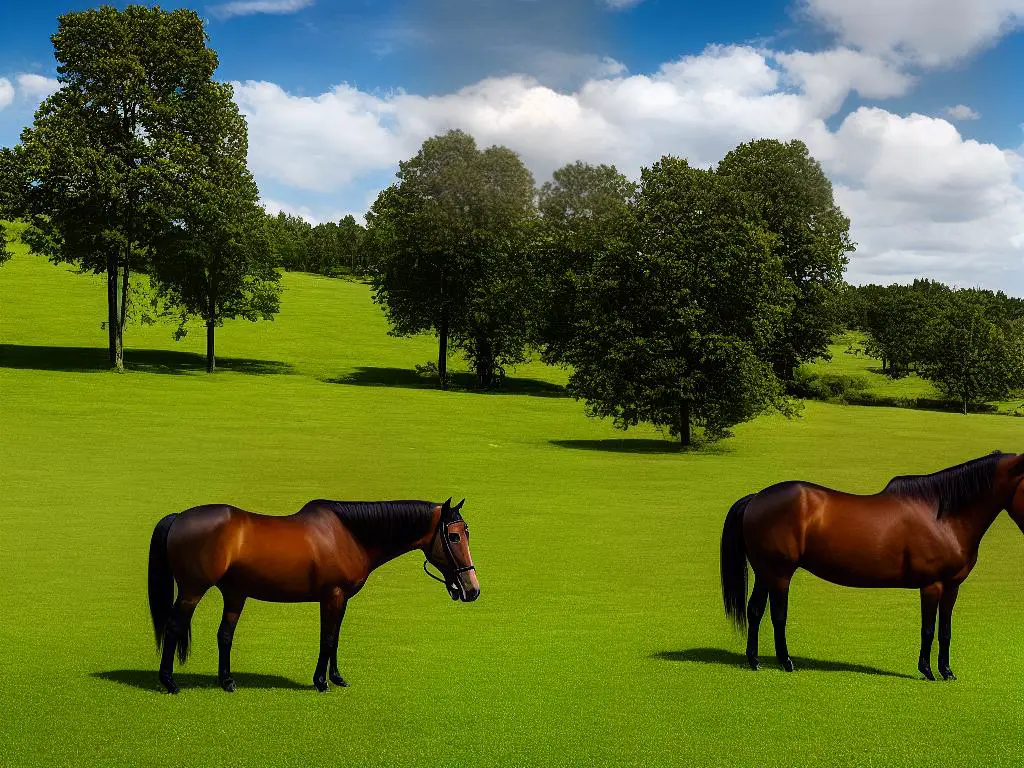Carrying an illustrious history, the Rheinlander horse breed has remained a dominant figure in the equestrian world. Known for their highly versatile nature, these noble animals are a seamless blend of strength, resilience, and grace. Originating from the Rhineland region of Germany, they were bred with an aim to serve multiple purposes including farm work, transportation, military use, and sport. Over the years, the breed has attained prominence in sports and show jumping, owed to their excellent physical traits and trainable temperament. This writing seeks to dive deep into the captivating world of the Rheinlander horses, tracing their journey from the past into the future, marking their physical traits, dietary needs, breeding practices and beyond.
Table of Contents (Horspedia)
History and Origin of Rheinlander Horse Breed
The Rheinlander Horse Breed
The Rheinlander horse breed, originating in the Rhineland region of Germany, boasts a rich and extensive history. Recognized and respected for their versatility and adaptability, these equine athletes have carved a distinct niche in global equestrian circles. To truly appreciate and understand the allure of these remarkable creatures, a journey back into their past is indispensable.
The Early Beginnings
Rheinlander horses, akin to many ancient breeds, trace their lineage back to a diverse mix of horses dating as far back as the Roman era. The breed as we know it today, however, started to be selectively bred in the late 19th century. The Rhineland Studbook was established in 1892 with the aim of developing a sturdy and economical working horse that could serve the needs of the agricultural sector at that time, which constituted predominantly of small and medium-sized farms.
The Aim of Breeding and Early Utilizations
The primary purpose for breeding Rheinlanders was for agricultural work. They were required to be sturdy, robust, and adaptable – capable of adjusting to varying climatic conditions and work demands. Owing to their exceptional strength and endurance, they were predominantly used for plowing fields and pulling heavy loads. However, the breed wasn’t rigidly confined to farm labor. Their commendable temperament and smooth gait also rendered them a popular choice for riding and driving.
World War Influences on the Development
With the advent of the First and the Second World War, there arose a demand shift towards lighter, more versatile horses that could function in a warfare environment. This led breeders to introduce Thoroughbred, Trakehner and Hanoverian bloodlines into the Rheinlander breed to reduce their size and enhance their agility. Simultaneously, this careful incorporation of various equine characteristics imbued the Rheinlander with a composite of unique traits – a fusion of strength, elegance, adaptability and versatility.
Post-War Evolution and Modern Rheinlander
Post World War II, with the advent of modern farming machinery, the need for working horses diminished significantly. The fate of the Rheinlander breed, like many other workhorse breeds, was thus hanging in the balance. To ensure their survival, emphasis was laid on turning them into sport horses. Breeding was redirected towards creating a breed suitable for both dressage and show jumping. The result was a more elegant Rheinlander, retaining their earlier strength but now coupled with grace, flexibility and fitness essential for equestrian sports.
Legacy
The Rheinlander horse is a widely respected breed within equestrian circles, admired for its unique combination of strength, grace, and phenomenal work ethic. Throughout the centuries, even as roles and demands have shifted, these horses have remained a solid symbol of resilience and adaptability. This is a testament to the foresight of the breed’s original developers and the versatility embedded within this breed’s DNA.

Physical Characteristics and Temperament of Rheinlander Horse
Physical Features of Rheinlander Horses
Born out of the Rhinelands region in Germany, the Rheinlander horse is a large, appealing breed that stands out due to its size and variety in colors. These horses generally measure between 16 and 17 hands (64 to 68 inches). This height, balanced with an agile build, makes them adept at a range of equestrian activities, including dressage and show jumping.
Rheinlanders are built sturdily yet gracefully, noted for their large, expressive heads, medium-long necks, and deep, broad chests. Their athletic and streamlined physique demonstrates agility and power, despite their large stature, reflecting more than just physical bulkiness.
Their coat colors display an impressive variety, with bay, brown, black, gray and chestnut being the most common ones. However, rarer colors like roan and pinto also exist. Additionally, distinctive facial markings, such as stars, stripes, snips and leg markings like socks or stockings, can often be seen on these horses.
Rheinlander Horse Temperament
If you’re in search of a breed that aligns remarkable physicality with an equally impressive temperament, look no further than the Rheinlander horse. Famed for their intelligence, they have a natural inclination towards quick learning and relish mind-stimulating challenges. Their aptitude for learning is a wonderful asset, paving the way for their adaptability across various disciplines and with riders of varying levels of experience—from novices to professionals.
Trainability is another notable feature of the Rheinlander breed. Their motivation to satisfy their riders and an innate desire to work hard sets them apart as the ideal pick for dressage, eventing, and even for simply enjoying a pleasure ride.
As for stamina, the Rheinlander impresses with its endurance. Capable of immense power and sustained energy, they are equipped to participate in lengthy, physically taxing equestrian events. Their long-reaching strides, coupled with a spirited yet controlled demeanor, greatly enhance their endurance capacity.
The Rheinlander breed presents a flexible suitability criteria. They shine in professional competitions, but they also offer fantastic companionship for pleasure riders, owing to their tranquil, serene, and patient personality.
It’s important to highlight the Rheinlander breed’s emotional intellect. These horses bond deeply with their owners, displaying authentic affection, loyalty, and faith in their human partners. This underscores the depth of their character as not just competitive accomplices, but also as affectionate, long-lasting companions. The Rheinlander horse, having charmed generations with their physical allure as well as their engaging temperament, continue to stand as a distinguished breed.

Care and Maintenance of Rheinlander Horse
About Rheinländer Horses
Rheinländer horses—a breed renowned for their multi-faceted skills, outstanding athleticism, and calm disposition—stem from the Rhineland region in Germany. They have earned popularity in dressage, show jumping, and combined driving fields. The Rheinländer’s ability to adapt is a key attribute, and while their care and maintenance adhere to the universal principles of horse management, it is important to pay special attention to their dietary requirements, regular exercise, and the prevention of potential health issues.
Feeding Habits and Dietary Needs
Rheinländer horses, like most horses, need a diet consisting primarily of forage such as grass and hay. Research shows that a horse should eat 1% to 2.5% of its body weight in hay or grass per day, depending on its activity level. Grain and other commercial feeds can complement this forage diet, especially for highly active Rheinländers involved in sports or heavy work. However, these should be given in moderation to avoid digestive disorders like colic. Horses also need access to fresh and clean water throughout the day.
Grooming Needs
Grooming your Rheinländer regularly is important for their health and well-being. Regular brushing removes dirt, dust, and dead hair, and it also allows you to check for any injuries or skin conditions that might need attention. Hoof care is a crucial part of their grooming routine. Cleaning it regularly and having a farrier check on them every six to eight weeks can prevent problems like thrush and lameness.
Exercise Requirements
Being athletic as they are, Rheinländer horses flourish with regular exercise. The exact amount depends on the horse’s age, fitness level, and job. Nonetheless, they typically benefit from at least one hour of exercise per day. This can be comprised of riding, lunging, free-play in an enclosure, or a combination thereof. Remember, regular exercise helps in maintaining their physical health and mental well-being but overdoing can lead to injuries and other health complications.
Weather Preference
Rheinländer horses are hardy and adaptable, and they can comfortably live in a variety of climates. However, they traditionally hail from a region with mild summers and cool winters. Hence, in excessively hot or cold climates, your Rheinländer may require some additional care like using cooling techniques during scorching summers and providing a warm blanket and stable during harsh winters.
Health Issues and Veterinary Care
Like all breeds, Rheinländers have some breed-specific health concerns that need to be monitored. They are more predisposed to certain orthopedic problems, digestive disruptions, and respiratory issues. Routine veterinary care, including vaccination, deworming, and regular health check-ups, is vital to catching and treating potential problems early. Working closely with your vet is the best way to ensure your horse’s health needs are met.
Introduction
A proper understanding of a Rheinländer horse’s diet, exercise, grooming, and health requirements is crucial. These horses excel when in a carefully tended environment, making them loyal and long-lasting companions. Routine veterinary visits, well-balanced nutrition, sufficient physical activity, meticulous grooming, and a fitting living ambiance significantly contribute to their welfare and happiness. The commitment to their upkeep not only boosts their health and comfort but also enhances their performance, providing great satisfaction for the horse owner.

Rheinlander Horse in Sports and Show Jumping
About Rheinlander Horses
Over the years, Rheinländer horses have gained substantial regard in the equestrian sports world thanks to their outstanding performances across various events. Native to Germany, this breed exudes a unique combination of elegance, might, and stamina. Because of these qualities, Rheinländer horses have become a top pick especially for sports such as dressage, show jumping and eventing.
Rheinlander Horse in Dressage
Dressage is one equestrian sport that Rheinlander horses excel in. The breed’s balanced and rhythmic movement plays an advantageous role in dressage which places a heavy emphasis on precision, smoothness, and fluidity. Some of the most renowned Rheinlander horses, such as Rubinstein I and Florestan I, have shown exceptional talent in dressage, achieving top rankings and winning championship titles at national and international levels. Their effectiveness in dressage is also owed to their submissive nature and a willingness to cooperate with riders, which are essential traits for succeeding in this discipline.
Performance in Show Jumping
Show jumping is another equestrian discipline where Rheinlander horses shine. They possess the strength, agility, and courage necessary for jumping over the hurdles of varying heights and widths. The breed’s notable jumping ability is the result of several generations of selective breeding, combining traits from Thoroughbreds, Hungarian horses, and trakehners. Donnerhall and De Niro, who are both Rheinlander horses, have exhibited exceptional skill in show jumping, earning international recognition and bringing pride to the breed.
Rheinlander Horse in Eventing
Eventing is possibly one of the most demanding equestrian sports, and here, too, Rheinlander horses prove their mettle. This three-phase competition – testing dressage, cross-country riding, and show jumping skills – requires a horse to be versatile, resilient, and enduring. The Rheinlander horse’s diverse genetic pool, coupled with its powerful build, plays a large role in its success in the eventing discipline. Comprising stamina from their Thoroughbred lineage, coupled with the balance and strength of their warmblood ancestry, Rheinlander horses are perfectly designed for the high-intensity demands of eventing.
Qualities of Rheinlander Horse for Equestrian Sports
Not to be overlooked are the inherent qualities of Rheinlander horses, which make them a preferred breed for equestrian sports. They are known for their intelligence, versatility, and sociability. Being easy to train, receptive to learning, and able to adapt to various environments and tasks are traits that are treasured in the competitive realm of equestrian sports. Furthermore, their distinct combination of power and grace makes them suitable for both strength-demanding and technique-oriented disciplines.
Rheinlander horses: A Versatile Athlete in Equestrian Sports
With their remarkable abilities to power through various disciplines of equestrian sports, Rheinlander horses exemplify both versatility and athleticism. Their performances in dressage, show jumping, and eventing reflect a balanced blend of endurance, bravery, and agility to meet these sports’ intense demands. By combining sophistication and strength, the Rheinlander breed consistently ranks high in equestrian competitions, thus setting and raising the bar of excellence within these sports.

Breeding and Conservation of Rheinlander Horse
Rooted in the Rhinelander region of Germany, the Rheinlander horse is a warmblood breed known for its versatility and athletic prowess. Despite their superior qualities, the Rheinlander breed is notably scarce with scarce numbers. This scarcity has sparked dedicated efforts toward breeding and conserving the breed, aiming to both expand their population size and protect the breed’s genetic integrity.
Breeding Practices of Rheinlander Horses
Breeding practices for Rheinlander horses are meticulous and regulated. The goal is to maintain the breed’s desirable traits while enhancing their athletic performance. The Rheinlander horse breeders adhere to a system of stringent evaluations and approvals for the horses qualified for breeding. This involves genetic evaluations, performance testing, and conformation assessments to ensure they meet the breed’s standards and maintain Rheinlander horses’ distinct qualities.
The selection process is stringent due to the primary goal of preserving the high quality of the breed. Stallions and mares must meet specific criteria before being approved for the breeding program. These criteria include certain performance levels in dressage and jumping, optimal pedigree quality, and overall physical health.
Genetic Qualities of Rheinlander Horses
The genetic qualities of Rheinlander horses make them highly valued. They are known for their endurance, large size, competitive spirit, and athleticism. Their versatility allows them to excel in various equestrian sports such as dressage, show jumping, and eventing.
Rheinlanders possess a kind and cooperative temperament, making them an excellent choice for both professional and amateur riders. Their commitment to work, adaptability, and intelligence also set them apart. These genetic qualities are a key focus of the breeding programs, ensuring they are passed on to the next generation.
Conservation of the Rheinlander Horse
Efforts to conserve the Rheinlander horse breed are crucial due to their limited numbers. These conservation initiatives encompass maintaining the population and enhancing their genetic diversity to prevent inbreeding.
The Rheinlander Breeding Association in Germany leads these efforts, working to protect the breed’s genetic integrity and future. They organize various breeding schemes, fund research projects, and collaborate with international breed societies to maintain the Rheinlander breed’s health and longevity.
Ideal Rheinlander Horse
The ideal Rheinlander horse showcases a harmonious blend of their desired traits and qualities. They should have a sturdy and balanced build, conducive to athleticism and performance. The ideal Rheinlander horse should also exhibit a positive temperament, showing eagerness to work coupled with gentleness and adaptability.
They should also have a sound health status, excellent muscular development, and optimized genetic traits for performance in competitions. Meeting these standards ensures the survival of the breed’s inherent traits and prevents dilution of the gene pool.
In summary, the breeding and conservation of Rheinlander horses are essential in preserving their legacy and ensuring the breed’s continuation. Significant work is being put into implementing rigorous breeding practices, ensuring the preservation of the breed’s genetic qualities, and carrying out conservation initiatives. All these efforts go towards sustaining the breed to allow future generations to appreciate the distinctive and revered Rheinlander horse.

From the historical evolution to the contemporary positioning, Rheinlander horses exemplify dedication and adaptability in every sense. Over centuries, these majestic creatures had been subjected to meticulous breeding, resulting in the refinement and enrichment of their genetic qualities. Today, they stand out not only for their athletic build and exceptional trainability, but also for their endurance and high-performance capabilities in equestrian sports. The continued endeavors for Rheinlander horse’s conservation and improved breeding practices reflect our commitment to preserving this legacy. It’s evident that the Rheinlander, as a breed, carries a strength and sophistication that is born out of a rich ancestry and attention to detail, making them one of the most desired horse breeds worldwide.